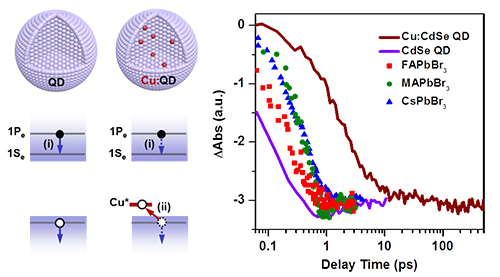A research group led by Prof. WU Kaifeng from the Dalian Institute of Chemical Physics (DICP) of the Chinese Academy of Sciences (CAS) recently reported the first observation of a phonon bottleneck for hot electron relaxation copper-doped colloidal quantum dots.
In conventional solar cells, the excessive energy of carriers above the band gap of a semiconductor is lost to heat due to rapid cooling (thermalization) of hot carriers via emission of phonons. This is a major reason for the well-known Shockley–Queisser limit for solar cell efficiency.
Hot carrier extraction to selective contacts has been envisioned as a promising means to overcome this limit, which has the potential to boost power conversion efficiency of solar cells to as high as 66%. The challenge in efficient hot carrier extraction lies in that intraband cooling of hot carriers usually occurs on a sub-ps timescale.

Femtosecond hole capturing by copper dopants in colloidal cadmium selenide quantum dots slows down their hot electron cooling by more than 30-fold. (Image by WANG Lifeng)
It is thus essential to suppress the rate of hot carrier cooling. Semiconductor quantum dots (QDs) were predicted to exhibit a “phonon bottleneck” for hot electron relaxation as their quantum-confined electrons would couple very inefficiently to phonons. However, typical CdSe QDs, for example, still exhibit sub-picosecond hot electron cooling, by passing the phonon bottleneck possibly via an Auger-like process whereby the excessive energy of the hot electron is transferred to the hole.
Realizing the detrimental role of the Auger-type cooling mechanism, the key to enabling a phonon bottleneck and to prolonging hot electron lifetime is to decouple the electron from the hole and thus to suppress energy transfer between them.
In this work, WU and his coworkers showed that, in copper-doped CdSe QDs prepared by a simple one-pot colloidal synthesis, photogenerated holes were captured by copper dopants on a femtosecond timescale (<< 390 fs). This femtosecond hole capturing thus competed favorably with the sub-ps Auger-type, electron-to-hole energy transfer. Hole capturing also likely led to electron wavefunction shrinkage, suppressing hot electron relaxation via nonadiabatic transitions induced by surface ligands.
As a result, they observed a lifetime of ~8.6 ps for 1Pe hot electrons which is more than 30-fold longer than that in same-sized, undoped CdSe QDs (~0.25 ps). Moreover, the hot electron energy loss rate of copper-doped QDs (0.075 eV/ps) was found to be more than 20-fold slower than those of various types of lead halide perovskites being intensively studied of late for hot carrier devices.
The observation of a phonon bottleneck in QDs not only is a verification of a long-existing theoretic prediction, but also offers an exciting opportunity of utilizing the long-lived hot electrons for high-efficiency photovoltaics and photocatalysis.
The above results were recently published in Nat. Commun..
This work was supported by the Ministry of Science and Technology of China, the Chinese Academy of Sciences, the National Natural Science Foundation of China and the LiaoNing Revitalization Talents Program. (Text by WANG Lifeng)